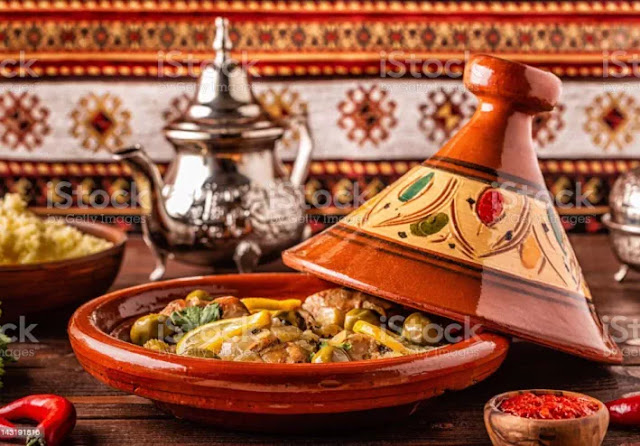If you're looking for a flavorful, hearty dish that is packed with bold spices and tender meat, Moroccan tagine is an excellent choice. This classic North African dish is traditionally cooked in a special earthenware pot, also called a tagine, which is designed to trap steam and help to cook the ingredients evenly. In this article, we'll explore the traditional way of preparing Moroccan tagine, including the ingredients and spices used, and the step-by-step cooking process.
Firstly, let's talk about the ingredients used in Moroccan tagine. This dish typically consists of a mix of meat, such as lamb, beef, or chicken, along with vegetables and spices. Onions and garlic are often used as the base for the dish, while vegetables like carrots, potatoes, and tomatoes are added for flavor and texture. In addition, Moroccan tagine is known for its use of spices, including cumin, coriander, turmeric, ginger, and cinnamon, which add depth and complexity to the dish.
To prepare Moroccan tagine, start by browning the meat in a tagine or heavy-bottomed pot over medium-high heat. Once the meat is browned, remove it from the pot and set it aside. Next, add onions and garlic to the pot and cook until softened. Then, add the remaining vegetables and spices and stir to combine. Return the meat to the pot, along with any accumulated juices, and pour in enough water or broth to cover the ingredients.
Cover the pot with a lid and reduce the heat to low. Allow the tagine to simmer for several hours, until the meat is tender and the flavors have melded together. Some recipes may call for the addition of dried fruit, such as apricots or raisins, which add sweetness and balance out the spices.
Finally, once the tagine is cooked, serve it hot, garnished with fresh herbs like parsley or cilantro. Moroccan tagine is often served with couscous, a type of small pasta made from semolina flour, which is a perfect accompaniment to soak up the flavorful sauce.
Furthermore, than just a dish, Moroccan tagine is a cultural icon that has been enjoyed for centuries by people across North Africa and beyond. By following the traditional preparation methods, you can experience the true flavors and aromas of this beloved dish. Moreover, the use of spices and ingredients in Moroccan tagine not only add a delicious taste to the dish but also bring a range of health benefits. For example, cinnamon is known to help regulate blood sugar levels, while ginger is believed to have anti-inflammatory properties.
In addition, if you're a fan of vegetarian or vegan cuisine, you can also enjoy a meatless version of Moroccan tagine by replacing the meat with chickpeas, lentils, or other legumes. This variation still packs a flavorful punch and is a great option for those following a plant-based diet.
Now, let's dive into the traditional way of preparing Moroccan tagine. First and foremost, you'll need a tagine pot, which is a clay cooking vessel with a conical lid. This special pot allows the ingredients to cook slowly and evenly, resulting in a tender and flavorful dish.
To start, heat the tagine pot over medium heat and add some olive oil. Then, sauté some onions and garlic until they become translucent. Next, add your meat of choice, such as chicken, lamb, or beef, along with a variety of spices, including cumin, coriander, paprika, turmeric, and cinnamon. These spices are what give Moroccan tagine its distinct flavor and aroma.
After the meat is browned, add some vegetables such as carrots, potatoes, and tomatoes. Pour in some chicken or vegetable broth and let everything simmer for about an hour, or until the meat is tender and the vegetables are cooked through. Finally, sprinkle some fresh herbs, like cilantro or parsley, over the top and serve the tagine with some fluffy couscous or crusty bread.
Alternatively, if you prefer a vegetarian version of tagine, you can skip the meat and use chickpeas, lentils, or a combination of both as the protein source. You can also add a variety of vegetables, such as eggplant, zucchini, and bell peppers, to make a hearty and nutritious meal.
Moreover, it's important to note that the preparation of Moroccan tagine isn't just about the ingredients and the cooking process. It's also about the cultural significance of the dish and the communal aspect of sharing a meal with loved ones.
In Moroccan culture, tagine is often served during special occasions, such as weddings and religious festivals, and is seen as a way to bring people together. It's a dish that is meant to be shared, with everyone sitting around the table, using bread to scoop up the flavorful sauce, and savoring each bite.
Moreover, tagine is also a versatile dish that can be customized to suit your taste preferences. You can use different types of meat or vegetables, adjust the amount of spices to your liking, and even add some dried fruits or nuts for a touch of sweetness.
In addition to being delicious and culturally significant, Moroccan tagine also has several health benefits. The use of spices like turmeric and cinnamon have been linked to reduced inflammation and improved digestion, while the vegetables in the dish provide a range of vitamins and minerals.
In conclusion, understanding the traditional way of preparing Moroccan tagine is an essential step towards experiencing the rich culture and delicious flavors of North Africa. By using a clay pot and slow-cooking a blend of meat, vegetables, and spices, you can create a savory and aromatic dish that is sure to impress. From the use of preserved lemons and saffron to the communal aspect of sharing a meal, the cultural significance of tagine cannot be overstated. So, whether you're a seasoned cook or a beginner, give this traditional Moroccan tagine recipe a try and transport your taste buds to the bustling streets of Marrakech.

